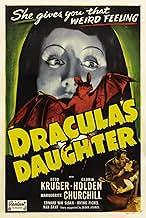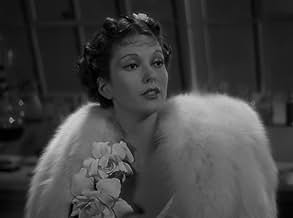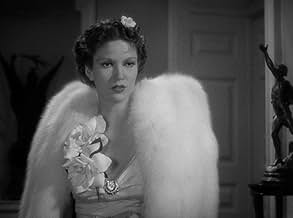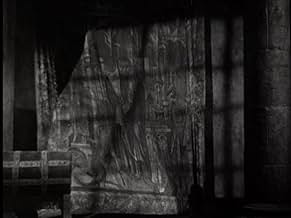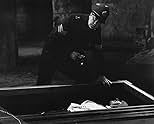NOTE IMDb
6,3/10
8,7 k
MA NOTE
Lorsque la comtesse Marya Zaleska apparaît à Londres, des événements mystérieux se produisent, conduisant le Dr Von Helsing à penser que la comtesse doit être un vampire.Lorsque la comtesse Marya Zaleska apparaît à Londres, des événements mystérieux se produisent, conduisant le Dr Von Helsing à penser que la comtesse doit être un vampire.Lorsque la comtesse Marya Zaleska apparaît à Londres, des événements mystérieux se produisent, conduisant le Dr Von Helsing à penser que la comtesse doit être un vampire.
- Réalisation
- Scénario
- Casting principal
- Récompenses
- 1 victoire et 1 nomination au total
Halliwell Hobbes
- Hawkins
- (as Halliwell Hobbs)
Claud Allister
- Sir Aubrey
- (as Claude Allister)
Agnes Anderson
- Elena
- (non crédité)
John Blood
- Bobby
- (non crédité)
David Dunbar
- Motor Bobby
- (non crédité)
Douglas Gordon
- Attendant
- (non crédité)
Owen Gorin
- Groom's Friend
- (non crédité)
Avis à la une
As the last movie completed before the Laemmles were ousted from control of Universal, DRACULA'S DAUGHTER holds some interest as a place marker, surely; now, the men who had fought the patent trust and had largely given way to the next generation. Yes, Zukor was hanging in as Chairman at Paramount, but with vastly curtailed power; DeMille was beginning his own renaissance -- by becoming a parody of himself -- and Lasky was still fading, although he would continue to produce increasingly ponderous prestige films over the next dozen years. Only Goldwyn would prosper -- but no one liked him.
But this is Dracula's Daughter I'm talking about, and it's just fine. I like Lambert Hillyer's frequently matter-of-fact handling of the movie, with its complicated lesbian and Triple-Goddess subtext. I can't see all the money on the screen (over a quarter of a million dollars -- a huge sum for Universal), but I am amused by the opening, with its "All right, Doctor, you've killed Count Dracula. You're claiming an insanity defense, are you?" attitude.
But this is Dracula's Daughter I'm talking about, and it's just fine. I like Lambert Hillyer's frequently matter-of-fact handling of the movie, with its complicated lesbian and Triple-Goddess subtext. I can't see all the money on the screen (over a quarter of a million dollars -- a huge sum for Universal), but I am amused by the opening, with its "All right, Doctor, you've killed Count Dracula. You're claiming an insanity defense, are you?" attitude.
Right after the success of James Whale's "Bride of Frankenstein" (sequel to "Frankenstein", also directed by Whale), Universal Studios decided to make a sequel to their other horror classic film, Tod Browning's "Dracula". Story says that the studio chose Whale again for the project, but his script proved to be too outrageous and subversive that was immediately rejected. It would be Garret Fort, writer of the first "Dracula", who would give flesh to the sequel's screenplay and the experienced director Lambert Hillyer was set to direct it. Like "Bride", this sequel would be focused on a feminine version of the previous monster; it's name, "Dracula's Daughter".
The film starts right after the original ends, with Count Dracula killed by Professor Van Helsing (Edward Van Sloan), however, to his misfortune, he is arrested for the murder of the Transylvanian nobleman and sent to prison as nobody believes he killed an ancient vampire. Realizing that nobody will believe him, Van Helsing asks the help of his dear friend, Dr. Jeffrey Garth (Otto Kruger), a former student of his who has become a prominent psychiatrist. While this events happen, a mysterious woman steals Dracula's body and a new series of murders start, complicating Van Helsing's defense and Garth's investigation. To make things worse, Countess Marya Zaleska (Gloria Holden) arrives and her seductive charms will prove too strong for Garth to resist them.
Unlike "Frankenstein", where there was still material in the source novel to build up a sequel; in "Dracula"'s case things get complicated, as the monster is effectively killed at the end. However, Garret Fort builds up an original story of mystery, horror and even nods to screwball comedy. "Dracula's Daughter"'s themes of betrayal, deception, and the quest for redemption are dark indeed, but Fort manages to add some light-hearted moments that break the suspense in an appropriate manner. Another highlight is that the vampire's sex appeal is enhanced and explored even further than posterior sequels of the now-franchise.
Director Lambert Hillyer had a big experience directing many low-budget films, ranging from westerns to crime dramas, so he was used to work with similar budget constrains. The movie's strength is in its story, and Hillyer knew it, so he keeps a simple yet very effective style that, while nothing too impressive, manages to create the perfect atmosphere for the plot. With nothing more than his well assembled cast and Fort's excellent screenplay, he conceives a film that maybe won't be remembered as influential, but will surely tell its story properly and deliver what it promises.
The cast is vital in this film, as their job is what sets apart the film from other Universal sequels. Otto Kruger is a very good lead actor, with nice looks and an ease for this kind of characters. He has great chemistry with both Gloria Holden and Marguerite Churchill and his performance is one of the film's highlights. Holden portrays the seductive Countess with power and grace in a complicated role as her character is at the same time dominated by a strong sex appeal and a sad and tragic fate. Churchill is superb in her comedy role, and more than mere comic relief, she adds the touch of screwball comedy to the film, giving her energy and charm. And finally, Edward Van Sloan returns as the experienced Van Helsing, and while his role here is more as a spiritual guide to Kruger, he gives another fine performance.
The film's main weakness is without a doubt its low-budget, that not only forced the choice of Hillyer as a director, but it also made it have less production values than other sequels. In a way, this may had been of help, as Hillyer's style bends together perfectly with low-budget projects and also gave the film a look closer to crime melodrama, which was rising in popularity at the time. Sure, Bela Lugosi is definitely missed, but "Dracula's Daughter" makes up for his absence with a witty (and bold for its time) screenplay and a well-assembled cast.
Time has left this film unappreciated, but there is a lot in there to praise, and while nowhere near the best of the Classic Universal Horror films, "Dracula's Daughter" is better than many of the films of its time, and an essential viewing for any fan of Gothic horror. 7/10
The film starts right after the original ends, with Count Dracula killed by Professor Van Helsing (Edward Van Sloan), however, to his misfortune, he is arrested for the murder of the Transylvanian nobleman and sent to prison as nobody believes he killed an ancient vampire. Realizing that nobody will believe him, Van Helsing asks the help of his dear friend, Dr. Jeffrey Garth (Otto Kruger), a former student of his who has become a prominent psychiatrist. While this events happen, a mysterious woman steals Dracula's body and a new series of murders start, complicating Van Helsing's defense and Garth's investigation. To make things worse, Countess Marya Zaleska (Gloria Holden) arrives and her seductive charms will prove too strong for Garth to resist them.
Unlike "Frankenstein", where there was still material in the source novel to build up a sequel; in "Dracula"'s case things get complicated, as the monster is effectively killed at the end. However, Garret Fort builds up an original story of mystery, horror and even nods to screwball comedy. "Dracula's Daughter"'s themes of betrayal, deception, and the quest for redemption are dark indeed, but Fort manages to add some light-hearted moments that break the suspense in an appropriate manner. Another highlight is that the vampire's sex appeal is enhanced and explored even further than posterior sequels of the now-franchise.
Director Lambert Hillyer had a big experience directing many low-budget films, ranging from westerns to crime dramas, so he was used to work with similar budget constrains. The movie's strength is in its story, and Hillyer knew it, so he keeps a simple yet very effective style that, while nothing too impressive, manages to create the perfect atmosphere for the plot. With nothing more than his well assembled cast and Fort's excellent screenplay, he conceives a film that maybe won't be remembered as influential, but will surely tell its story properly and deliver what it promises.
The cast is vital in this film, as their job is what sets apart the film from other Universal sequels. Otto Kruger is a very good lead actor, with nice looks and an ease for this kind of characters. He has great chemistry with both Gloria Holden and Marguerite Churchill and his performance is one of the film's highlights. Holden portrays the seductive Countess with power and grace in a complicated role as her character is at the same time dominated by a strong sex appeal and a sad and tragic fate. Churchill is superb in her comedy role, and more than mere comic relief, she adds the touch of screwball comedy to the film, giving her energy and charm. And finally, Edward Van Sloan returns as the experienced Van Helsing, and while his role here is more as a spiritual guide to Kruger, he gives another fine performance.
The film's main weakness is without a doubt its low-budget, that not only forced the choice of Hillyer as a director, but it also made it have less production values than other sequels. In a way, this may had been of help, as Hillyer's style bends together perfectly with low-budget projects and also gave the film a look closer to crime melodrama, which was rising in popularity at the time. Sure, Bela Lugosi is definitely missed, but "Dracula's Daughter" makes up for his absence with a witty (and bold for its time) screenplay and a well-assembled cast.
Time has left this film unappreciated, but there is a lot in there to praise, and while nowhere near the best of the Classic Universal Horror films, "Dracula's Daughter" is better than many of the films of its time, and an essential viewing for any fan of Gothic horror. 7/10
"Dracula's Daughter" is a trailblazer in many respects. It's the earliest film I can think of that features a truly sympathetic vampire protagonist. It's also the earliest mainstream film that I'm aware of with such a strong lesbian subtext. (Actually, it's not even a "sub" text, it's plain as day!) As you might expect, these rather surprising elements make it a highly memorable viewing experience - perhaps even more memorable than its predecessor, Lugosi's "Dracula," which is basically just a truncated version of Bram Stoker's novel.
Unfortunately, "Dracula's Daughter" misses the mark of greatness that it probably deserves. The film is only about an hour and ten minutes long, so there isn't sufficient time to fully develop Countess Zaleska, the title character. And it's extremely frustrating that the first fifteen minutes or so are basically squandered on a lot of painfully unfunny business involving two comedy constables. The humor has aged really, really badly, unless you somehow find it convulsively hilarious when one of the constables reacts to every strange and dramatic happening around him by saying "oooh..."
I tend to complain that modern-day horror features too much dumb comedy that hurts its credibility, but "Dracula's Daughter" is living proof that studios were injecting silly rubbish into otherwise good horror material as long as seventy years ago!
The serious parts of the film work well, however. Countess Zaleska and her faithful servant, Sandor, have some interesting exchanges about the loneliness of immortality and the darkness of the vampire's universe. The scene when Zaleska burns her father's body is also very moody and dramatic. (How does one get a job like Sandor's, anyway? Don't you think it would be fun to play personal servant to a glamorous female vampire? No? Maybe it's just me, then.)
If the film has another flaw, aside from the comedy, it's the human protagonist, Dr. Garth. Otto Kruger plays the character as stubborn and really rather abrupt. He'll spew a few lines of psycho-babble at the countess, then charge out of the room and leave his job with her half-done at best. A more attentive psychiatrist might perhaps have made for a more sympathetic and proactive hero. As it is, he's basically just an irritating presence who distracts us from the "villains," who are infinitely more interesting and more worthy of our time.
Unfortunately, "Dracula's Daughter" misses the mark of greatness that it probably deserves. The film is only about an hour and ten minutes long, so there isn't sufficient time to fully develop Countess Zaleska, the title character. And it's extremely frustrating that the first fifteen minutes or so are basically squandered on a lot of painfully unfunny business involving two comedy constables. The humor has aged really, really badly, unless you somehow find it convulsively hilarious when one of the constables reacts to every strange and dramatic happening around him by saying "oooh..."
I tend to complain that modern-day horror features too much dumb comedy that hurts its credibility, but "Dracula's Daughter" is living proof that studios were injecting silly rubbish into otherwise good horror material as long as seventy years ago!
The serious parts of the film work well, however. Countess Zaleska and her faithful servant, Sandor, have some interesting exchanges about the loneliness of immortality and the darkness of the vampire's universe. The scene when Zaleska burns her father's body is also very moody and dramatic. (How does one get a job like Sandor's, anyway? Don't you think it would be fun to play personal servant to a glamorous female vampire? No? Maybe it's just me, then.)
If the film has another flaw, aside from the comedy, it's the human protagonist, Dr. Garth. Otto Kruger plays the character as stubborn and really rather abrupt. He'll spew a few lines of psycho-babble at the countess, then charge out of the room and leave his job with her half-done at best. A more attentive psychiatrist might perhaps have made for a more sympathetic and proactive hero. As it is, he's basically just an irritating presence who distracts us from the "villains," who are infinitely more interesting and more worthy of our time.
Dracula's Daughter is a Universal monster movie made in 1936, picking up where the original Dracula left off. The opening scene has the police discovering that Dr. Van Helsing has just staked Count Dracula. The plot moves quickly on with two strands, one involving a friend of Van Helsing.....Dr. Jeffrey Garth....in pursuit of defending his colleague and the other strand involving the daughter of Dracula....Marya Zaleska....in London trying to rid herself of her family curse finding it an impossible task. The two strands finally meet and intertwine. The movie has some rather obvious shortcomings. One is Otto Kruger, whom is irritating as one reviewer earlier stated. He is lacklustre and pompous in a very hollow way. The film also lacks a credible story line and is given in to the temptation of assuming a great deal from the viewer. However, Dracula's Daughter still is a very enjoyable film. It has wonderful atmosphere, grand sets(particularly when in Translyvania), and a good performance from Holden as the lead and Van Sloan in a reprise of his role as the good doctor Van Helsing. Above all it has a wonderfully eerie, disturbing, and macabre performance from Irving Pinchel as the servant of the female vampire. He is her reminder of what she is, and he never lets her forget that curse which forces her to live by night and sleep by day.
After years and years of being a Universal horror fan, I finally see "Dracula's Daughter". What an interesting and haunting film it is,too. It's way ahead of the curve in portraying a vampire that wants to escape its cursed existence. The "daughter" of the title longs to live as a real woman but must answer the call of her blood. Is she really a blood relation to Count Dracula or merely a past victim who was especially close to him? Beginning exactly where Todd Browning's "Dracula" left off years earlier, we see Prof. van Helsing arrested for murder when he is found in the vicinity of Dracula's staked-out body. The dull-witted police commissioner believes van Helsing is either a lunatic or a liar but respects his scientific credentials enough to keep him out of jail. Van Helsing seeks the aid of his old student, psychiatrist Jeffrey Garth, to prove his innocence.
Meanwhile, in a truly unusual scene, the body of Count Dracula is stolen from a pair of bumbling policemen by Countess Marya Zaleska and her pale, sinister servant Sandor. The undead Countess merely wants to give Dracula a dignified cremation by fire. His torment is over, but Marya's lingers. She is struggling mightily to resist the call to vampirism but Sandor seems to encourage his mistress to enjoy her bloody deeds.
Through a tangled web of fate, Prof. Garth and Countess Zaleska become entwined. The Countess begs the psychiatrist to give her the willpower to escape her "obsession"...meanwhile, Garth is becoming uneasily aware of Marya's link to several vampire-like murders that have occurred in town. Most tellingly, he notes that her apartment does not have a single mirror...a sure sign of a vampire, according to Van Helsing.
It all ends in Transylvania as the forces of good and evil collide once more.
Gloria Holden is striking as "Dracula's Daughter". Her exotic Slavic looks and wide, hypnotic eyes make it easy to believe she is more than merely human. She has a tragic aura to her, but when she seduces a young girl to become a victim, she also seems repellent.
The real monster of the movie is Sandor, who seems to be manipulating Marya for his own evil ends. Irving Pichel later became a director of some repute, but here he is a scary, foreboding presence with his ominous bass voice, deathly pale skin and Russian garb. Sandor's relationship with Marya is truly unique, as he talks to her as an equal, not a servant.
Otto Kruger is great as Jeffrey Garth, a man of reason and wit who is thrust into the twilight world of the undead. Kruger was a very under-rated actor who should have been more well-known. His sarcastic romantic sniping with his sexy and uppity secretary comes across just as well as his more serious dialogs with van Helsing and Marya. He's a refreshing change from the usual David Manners type hero in the old Universals.
It's a real treat to see Edward van Sloan return in the role of Dr. van Helsing. Calm, rational and collected in his thoughts, he is a contrast to the unholy creatures he duels with. ONe wonders if van Helsing would be sympathetic to Countess Zaleska...or if he would be hell-bent on her destruction. Never do we hear van Sloan's van Helsing voice any understanding or sympathy for the vampires he stalks.
There's some odd comic moments...the two nitwit bobbies at the beginning in particular stick out like a sore thumb...and director Lambert Hillyer's vision of Transylvania seems more like a clichéd Germany, but "Dracula's Daughter" dares to be different from its more famous predecessor and in so doing, emerges as a bit of a classic itself.
Meanwhile, in a truly unusual scene, the body of Count Dracula is stolen from a pair of bumbling policemen by Countess Marya Zaleska and her pale, sinister servant Sandor. The undead Countess merely wants to give Dracula a dignified cremation by fire. His torment is over, but Marya's lingers. She is struggling mightily to resist the call to vampirism but Sandor seems to encourage his mistress to enjoy her bloody deeds.
Through a tangled web of fate, Prof. Garth and Countess Zaleska become entwined. The Countess begs the psychiatrist to give her the willpower to escape her "obsession"...meanwhile, Garth is becoming uneasily aware of Marya's link to several vampire-like murders that have occurred in town. Most tellingly, he notes that her apartment does not have a single mirror...a sure sign of a vampire, according to Van Helsing.
It all ends in Transylvania as the forces of good and evil collide once more.
Gloria Holden is striking as "Dracula's Daughter". Her exotic Slavic looks and wide, hypnotic eyes make it easy to believe she is more than merely human. She has a tragic aura to her, but when she seduces a young girl to become a victim, she also seems repellent.
The real monster of the movie is Sandor, who seems to be manipulating Marya for his own evil ends. Irving Pichel later became a director of some repute, but here he is a scary, foreboding presence with his ominous bass voice, deathly pale skin and Russian garb. Sandor's relationship with Marya is truly unique, as he talks to her as an equal, not a servant.
Otto Kruger is great as Jeffrey Garth, a man of reason and wit who is thrust into the twilight world of the undead. Kruger was a very under-rated actor who should have been more well-known. His sarcastic romantic sniping with his sexy and uppity secretary comes across just as well as his more serious dialogs with van Helsing and Marya. He's a refreshing change from the usual David Manners type hero in the old Universals.
It's a real treat to see Edward van Sloan return in the role of Dr. van Helsing. Calm, rational and collected in his thoughts, he is a contrast to the unholy creatures he duels with. ONe wonders if van Helsing would be sympathetic to Countess Zaleska...or if he would be hell-bent on her destruction. Never do we hear van Sloan's van Helsing voice any understanding or sympathy for the vampires he stalks.
There's some odd comic moments...the two nitwit bobbies at the beginning in particular stick out like a sore thumb...and director Lambert Hillyer's vision of Transylvania seems more like a clichéd Germany, but "Dracula's Daughter" dares to be different from its more famous predecessor and in so doing, emerges as a bit of a classic itself.
Le saviez-vous
- AnecdotesOriginally, Universal wanted to make a sequel based on Bram Stoker's short story 'Dracula's Guest' and negotiated with Stoker's widow Florence. During the talks between the two, it was discovered that Bram Stoker had not complied with one requirement of the U.S Copyright office with his novel 'Dracula', which rendered it public domain in the United States. Because Florence wanted more creative control over the sequel, and Bela Lugosi wanted more money to reprise the role of Count Dracula, Universal instead hired John L. Balderston to write a new story.
- GaffesAlthough the film takes place mostly in London, telephones consistently ring one ring at a time, whereas British phones have always used a double ring.
- Citations
Lady Esme Hammond: Sherry, Marya?
Countess Marya Zaleska: Thank you, I never drink... wine.
- ConnexionsFeatured in Shock Theater: Dracula's Daughter (1959)
Meilleurs choix
Connectez-vous pour évaluer et suivre la liste de favoris afin de recevoir des recommandations personnalisées
Détails
- Date de sortie
- Pays d’origine
- Sites officiels
- Langues
- Aussi connu sous le nom de
- La hija de Drácula
- Lieux de tournage
- Société de production
- Voir plus de crédits d'entreprise sur IMDbPro
- Durée1 heure 11 minutes
- Couleur
- Rapport de forme
- 1.37 : 1
Contribuer à cette page
Suggérer une modification ou ajouter du contenu manquant




